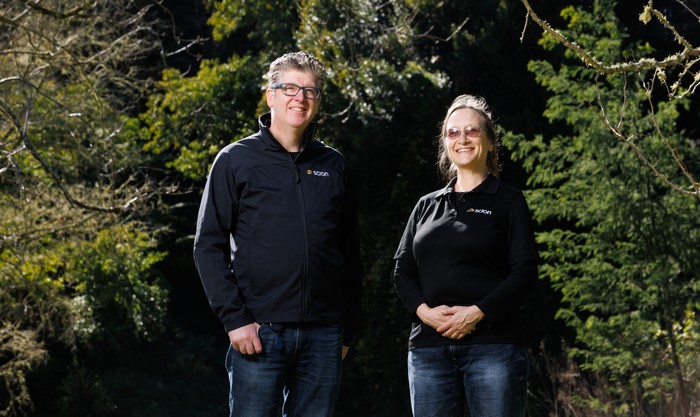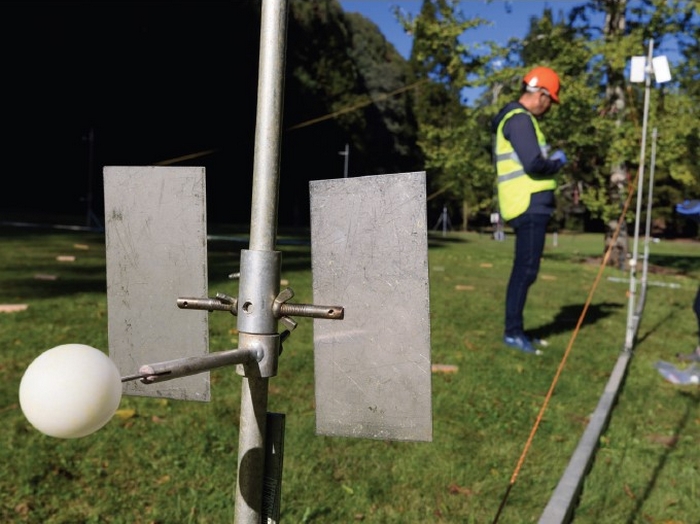UAVs for pest control take off
Research into unmanned aerial vehicle (UAV) use could open doors for ‘burgeoning’ practice, but refinement is key to combating plant pest incursions.
It’s 1999. The painted apple moth has been discovered in West Auckland. With the risk it could cause severe damage and financial losses to multiple industries and native and amenity trees, a multimillion-dollar response begins.

The eradication includes an extensive aerial spraying programme involving fixed-wing aircraft and helicopters. Given Ministry of Agriculture and Forestry estimates the moth could cause economic impacts of up to $356 million over 20 years if established, the extensive reaction is warranted despite some reluctance to spraying in an urban environment.
Seven years, $65m and about 70 sprays covering thousands of hectares later, the apple moth is eradicated.
Over the years, Scion researchers have been looking for new ways to tackle future pest and insect outbreaks. Ways that are more targeted and don’t require aerial spraying using such imposing aircraft.
And the work shows UAVs could be used for targeted spraying in urban biosecurity, once we understand what issues could emerge for people when using UAVs for this purpose.
There is no one tool that will work in every situation so it’s important we maximise what’s in our toolbox so we can better tailor our responses. - Brendan Gould
Could UAVs be the new frontier?
Scion has been involved with incursion responses and field research in aerial spray methodology for a long time, including when the painted apple moth was discovered. Research into both the social acceptance and practicalities of aerial spraying using UAVs specifically began around 2015. Several years and trials later, researchers are finalising their findings.
Plant Protection Physics and Chemistry team lead Dr Justin Nairn says his team’s work falls under the Better Border Biosecurity (B3) collaboration – a multi-partner joint venture researching ways to reduce the entry and establishment of new plant pests and diseases in New Zealand.
The research looked at the efficiency of spraying using UAVs in general, then using them to spray a specific biological insecticide.
“One of the big things that’s coming into plant protection is precision spraying – applying things as accurately as possible and minimising off-target spray,” Nairn says.
Alongside that, a team of social scientists looked at how accepting people were of UAVs and how to co-design responses.
UAVs can fly closer to the target than a helicopter – about 2m versus 10m-plus – have a smaller footprint and fly slower meaning down draft can help drive the spray through the canopy.
In aligned research, Dr Andrea Grant helped run focus groups looking at social and cultural considerations. They included social researchers from other Crown Research Institutes, UAV researchers, Māori involved in forest protection and management, and
forestry managers.
Focus group participants discussed social and technical aspects identifying emerging issues like human health, safety and ethics, professionalisation, Te Tiriti partnerships, communication and engagement, capacity and capability.
‘Burgeoning’ tool tested
In March 2021, Nairn’s team used a fluorescent dye to measure the efficiency of spraying with UAVs.
Approval was sought from Ngāti Hurungaterangi, Ngāti Taeotu and Ngāti Te Kahu whose whenua in Rotorua is where the testing took place.
A T16 drone, weighing 41kg fully loaded, made 10 flights measuring wake velocities and eight spraying dyes, passing over a tree on Scion’s campus four times each flight.
Sonic anemometers measured wake speed, while collectors placed through the canopy and on the ground, captured dye penetration levels and drift outside the target area.
They found the UAV wake drove the dye deep into the canopy and wind levels affected how far it veered off target. The next step was an insecticide trial.
They wanted to use Foray48B which is a BTK (Bacillus thuringiensis var. Kustaki) bio-insecticide impacting Lepidoptera (moths specifically), but availability of the insecticide delayed the trial until February this year.
Another challenge was droplet size. A small droplet size typically gives better coverage but is more susceptible to wind drift. The team created a dilution with the same portion of active ingredients in larger droplets to determine if they would adequately penetrate the canopy and provide sufficient coverage.
The findings are being written but Nairn says the use of UAVs for pest control is “burgeoning” and operation hurdles are reducing as technology advances, addressing cost and technological barriers like weight and flight time.
“As they become more useful people are more accepting of paying the cost.”

Overcoming social, cultural challenges
Before the most recent field testing, Grant held a co-design workshop with people from agencies including the Ministry of Primary Industries, Te Uru Rākau, Department of Conservation, Civil Aviation Authority and Te Tira Whakamātaki.
Grant says some social and cultural challenges identified included making off-the-shelf tools fit for purpose, ensuring people were sufficiently trained, and safety and operational ethics were considered.
She also looked at using ethical co-design as a framework for biosecurity incursion responses that are inclusive, based in Te Tiriti and enable Māori innovation.
She says participants noted the role for mātauranga Māori and need to work with Māori in research, policy, operation and capacity, developing relationships and resources that enable Māori participation.
There also needs to be a balance between engaging communities ahead of any response, and the need for fast action sometimes.
“This action-engagement trade-off needs more strategic attention and communities’ role in biosecurity operations could be better developed.
“If community concerns are not addressed and they have no opportunity to respond to planned operations, they may lose confidence and support for urban biosecurity operations in future.”
Te Tira Whakamātaki chief scientist Dr Simon Lambert says much of the Māori economy is in the primary sector and therefore highly reliant on the environment.
“Māori are increasingly aware of the vulnerability of their assets and cultural capital to biosecurity events and are not opposed to technological innovation but insist on early and ongoing engagement by researchers and regulators.”
If community concerns are not addressed and they have no opportunity to respond to planned operations, they may lose confidence and support for urban biosecurity operations in future. - Andrea Grant
Proactive biosecurity system
B3 director Dr Desi Ramoo says the research completed by Nairn’s team using UAV platform technology is a great example of adapting existing technology to be an applied biosecurity tool.
“We must be prepared with a number of solutions developed from Western science and mātauranga Māori to ensure we are ahead of the game and move from a reactive to proactive biosecurity system. To set us on the path to achieve this, building relationships with Māori is an essential requirement for all B3 research projects.
Our aim is research projects that will be the catalyst that builds enduring partnerships which enable rapid response when the need arises.”
Brendan Gould from the Forest Owners Association says successful intervention relies on the ability to respond but community impacts and implications need to be considered.
“There is no one tool that will work in every situation so it’s important we maximise what’s in our toolbox so we can better tailor our responses.
“Having more tools means we can better engage communities to develop effective strategies that can be rapidly deployed but that minimise potential impacts and are socially acceptable.”
He says engagement before an incursion is important but challenging without knowing where and when one might occur.
Engaging at a generic level means getting an idea of what impacts and implications might arise during a response and previously engaged groups can help develop tools or inform others.
“These projects have been hugely informative in terms of pre-engagement and have and will provide hugely valuable tools and information that we can draw on both before and during a response.”
Nairn’s work was part funded by Better Border Biosecurity (B3) while Grant’s was part funded by Forest Growers Research Trust. Both were funded by Scion’s Strategic Science Investment Fund.
